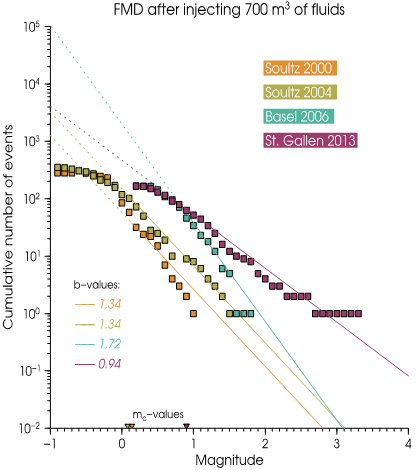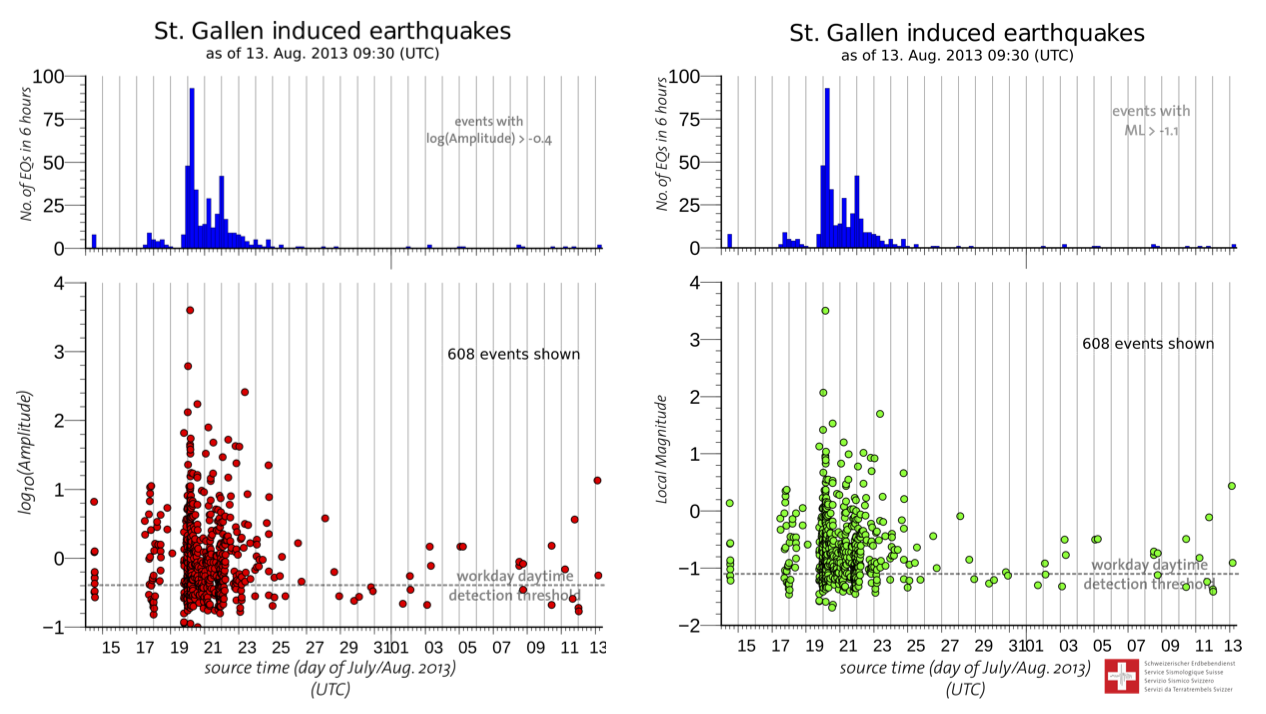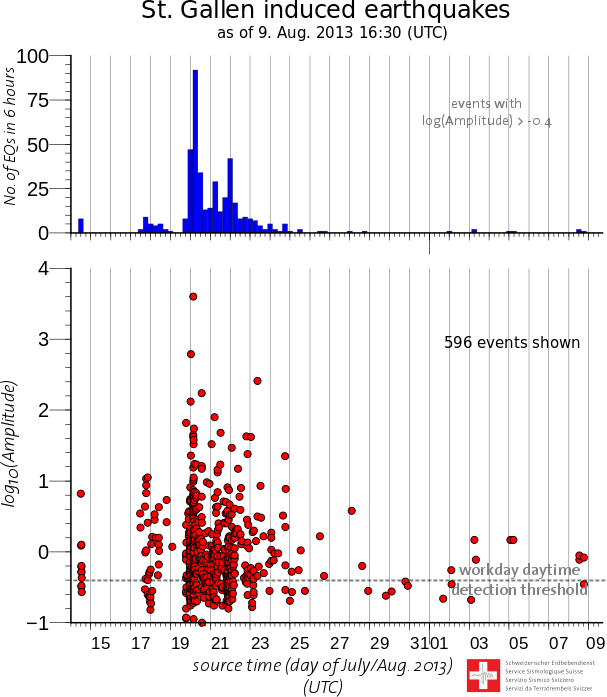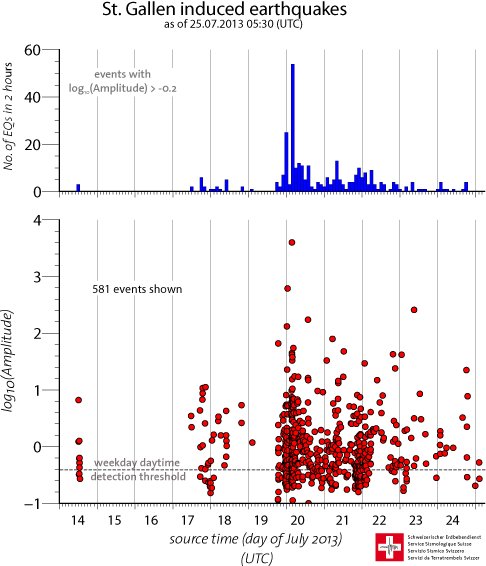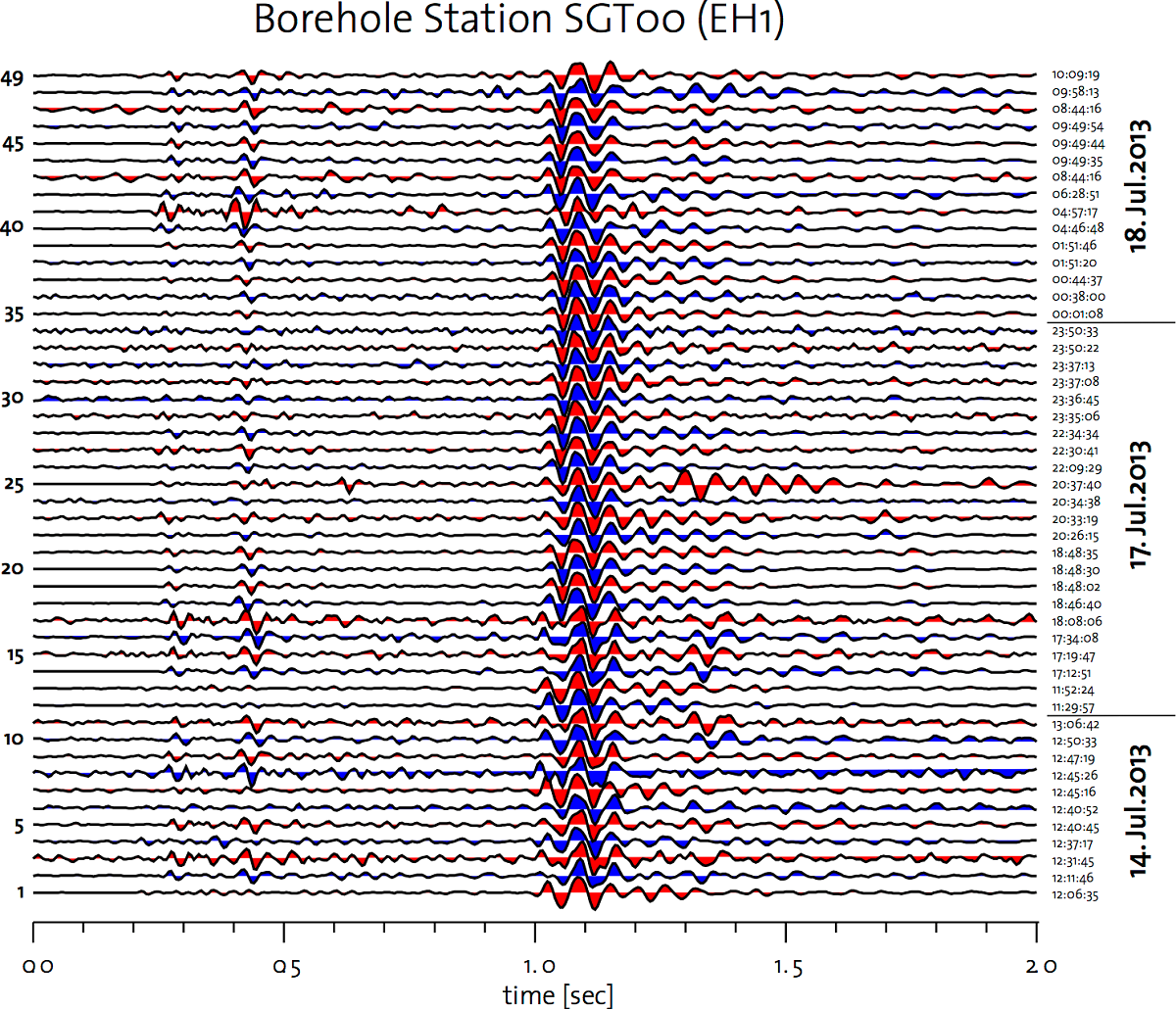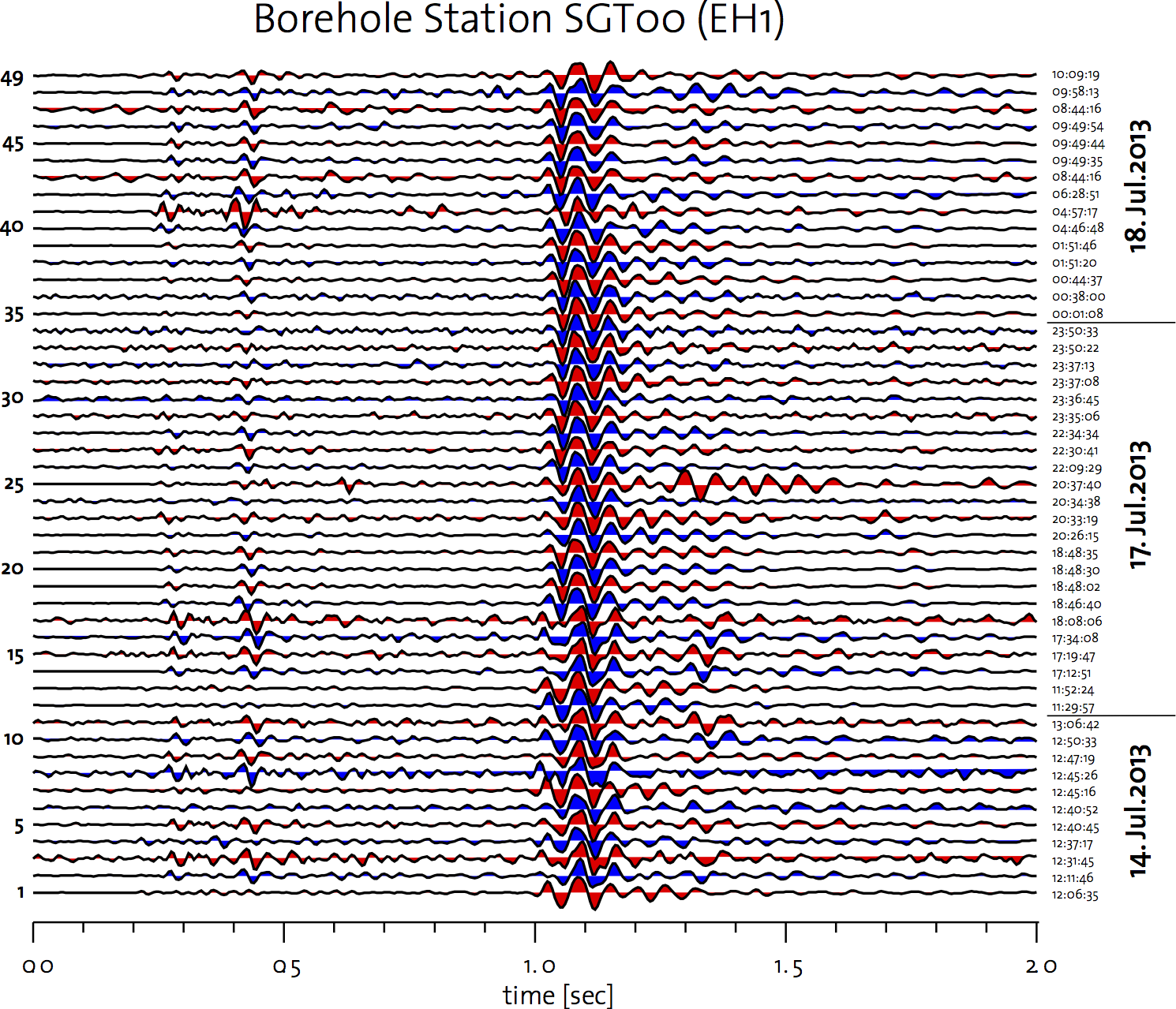Earthquake Chronology Geothermal Energy Project in St. Gallen
2013-11-15
Seismic Activity before, during, and after Production Tests in St. Gallen
Following the production tests at the start of November, the St. Gallen public utilities company (Sankt Galler Stadtwerke) completed the first phase of their geothermal energy project. It is currently evaluating the collected data and will determine the further course of action based on the results. The Swiss Seismological Service (SED) is likewise using this as an opportunity to take a look back, and presents an overview here of the findings obtained thus far.
As expected, earthquake activity in St. Gallen decreased steadily following the magnitude 3.5 earthquake on July 20, 2013. During preparations for the production tests, however, an increasing number of microearthquakes occurred since September 16, 2013. During this period, a total of 232 microearthquakes were recorded. The strongest took place on October 2, 2013, and had a magnitude of 2.0. With the start of the production tests on October 15, 2013, during which gas and water were extracted from the subsoil, earthquake activity decreased considerably. Since that time, the SED has recorded only four very weak events. These microearthquakes may have been aftershocks from the October 2, 2013, earthquake, and are thus not necessarily directly related to the production tests.
2013-11-15
Correlation between Pressure Conditions in the Subsoil and Induced Seismic Activity
An initial comparison of the induced seismic activity in St. Gallen with the activities at the geothermal borehole confirms the known correlation between the fluid pressure (pressure caused by fluids and gases) and the seismic activity: increased rates of earthquakes occur above all when pumping fluids into the subsoil (injection). Pumping fluids out of the subsoil (production), on the other hand, generally results in a decrease of the earthquake rate.
This observation was essentially proven correct in the late 1960s in a scientific experiment to monitor earthquakes in the Rangely oil field in Colorado (USA). It shaped the classic explanatory model of injection-induced seismic activity. This states that acting against the shear motion along a rupture surface in the bedrock is a frictional force that increases the stronger the rock blocks separated by the fault are pressed together. Only if the driving force of the shear motion is greater than the frictional force can abrupt shifts along the rupture surface and, thus, an earthquake occur. If fluids are present in the subsoil, the fluid pressure acts against the pressing together of the rock blocks, thereby reducing the frictional force on the rupture surface. If the fluid pressure increases, for example because fluid is pumped in, the frictional force is reduced further. In this case, the rupture surfaces can be more easily activated the higher the fluid pressure and the greater the tension of the rupture surfaces caused by tectonic processes. A decrease in pressure has the opposite effect: fewer earthquakes occur. Ongoing production (pumping out) of water can, however, also lead to an increase in earthquakes in the medium term, since the decrease in volume leads to redistributions of tension. For example, earthquakes have been triggered during the course of groundwater or oil and gas production.
Read more...During the experiment in the Rangely oil field, earthquake activity could be switched on and off by injecting and producing water. There are now also indications of a similar response in the St. Gallen geothermal energy project. Unfortunately, the classic model of injection-induced seismic activity does not provide a comprehensive explanation of the phenomenon. This is because, on the one hand, the frictional force is also dependent on the material properties of the rocks and the history of shifts in the bedrock. On the other hand, small-scale variations of these properties and the rock tension lead to a superposition of processes, which prevents reliable deterministic predictions. There is nevertheless hope that this deficit can be overcome through statistical real-time analysis and improved physical models of induced seismic activity. In collaboration with other working groups, the SED is currently developing such predictive models for induced earthquakes.
Due to the current state of scientific knowledge and the reasons mentioned above, it is difficult to make a reliable statement on the further development of induced seismic activity. It can be expected that, with the sealing of the borehole, the decreased reservoir pressure caused by the production tests will slowly increase to its natural level. During this phase, there is again an increased likelihood of induced earthquakes. It is not possible to exclude the possibility of earthquakes that can be felt. The probability for such earthquakes is, however, low.
"Production Tests Completed” – information from the St. Gallen public utilities company
2013-11-08
Microearthquakes in St. Gallen
After the steady decrease in both the magnitude and frequency of seismic activity in St. Gallen following the earthquake with a magnitude of 3.5 on July 20, 2013, there has been a renewed increase in the number of microearthquakes since September 16, 2013. More than 225 such earthquakes have been registered (state 15.10.2013). The strongest, with a magnitude of 2.0, occurred on October 2, 2013. Earthquakes of this magnitude are very sporadically felt locally.
Product tests will be conducted from October, 15 until the end of the month. Seismicity around the borehole might rise again due to these tests.
The Swiss Seismological Service (SED) continues to monitor the geothermal borehole and the surrounding area and to keep the St. Gallen public utilities company (Sankt Galler Stadtwerke) and the public constantly informed about the seismic activity recorded.
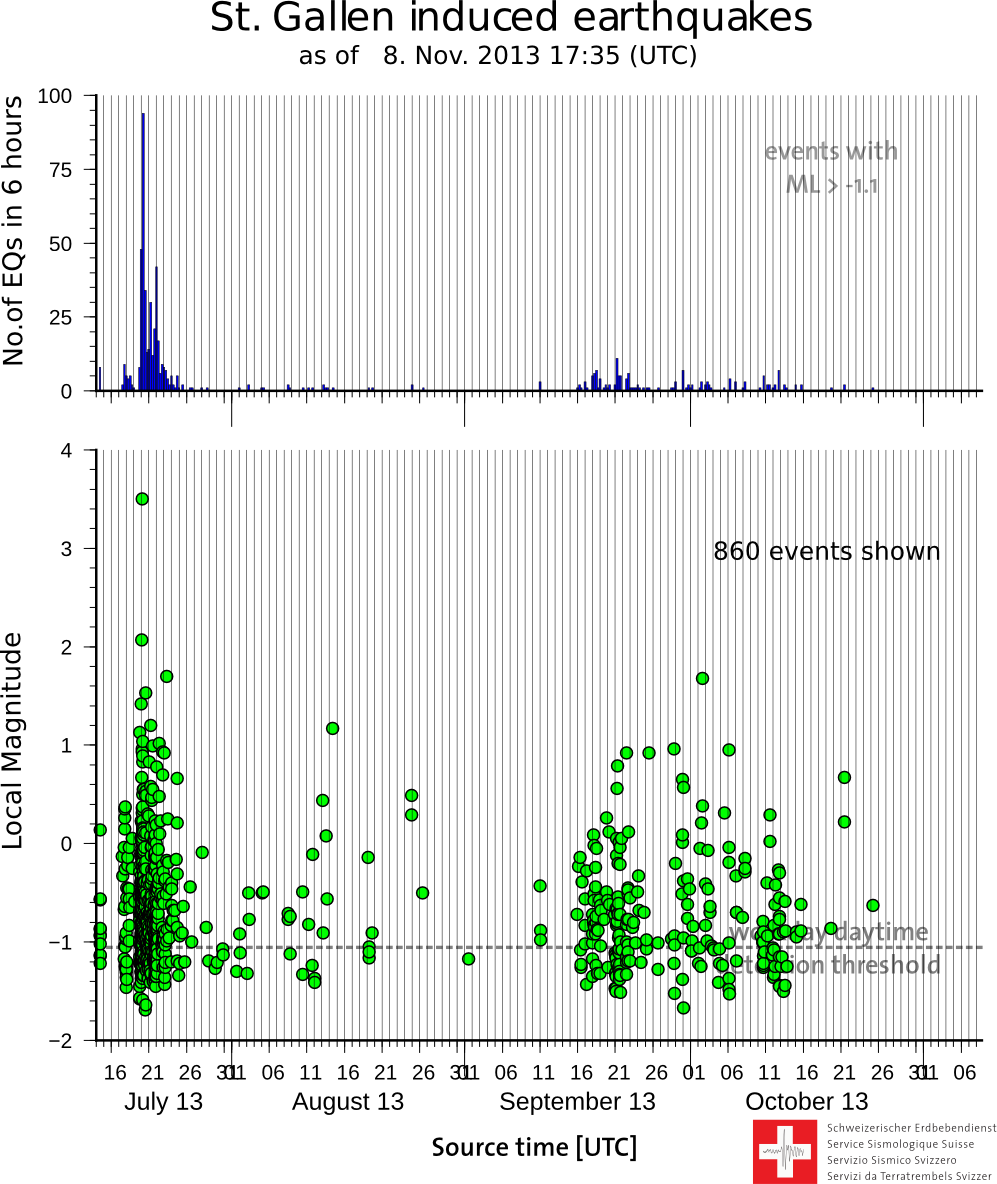
2013-09-21
Earthquakes: Geothermal Energy Project in St. Gallen
The test and stimulation activities carried out as part of the planned geothermal energy project in Sittertobel near St. Gallen began on July 14, 2013. The number and intensity of the microearthquakes induced were as expected and not noticeable to local residents. On the evening of July 19, seismic activity began to increase; the earthquakes became stronger and more frequent. The sequence achieved the highest peak so far on the morning of July 20, with a perceptible quake with a magnitude of 3.5. According to the latest findings, these earthquakes are directly linked to the steps taken to tackle the gas-water leak observed at midday on July 19.
Read more...Since then, seismic activity has fallen steadily. However, stronger quakes can still not be ruled out. The Swiss Seismological Service (SED) continues to monitor seismic activity in St. Gallen around the clock with the help of a dense, local network. The graph on the left shows the most recent record of seismic activity. Quakes with a magnitude of less than 0.5 are generally too weak to be accurately localized in the course of routine evaluation. They are not, therefore, registered in the regular earthquake lists. However, they can be recorded and clearly attributed to the seismic activity at the borehole.
The SED is currently analyzing the data collected in order to gain a better understanding of the processes responsible for the observed earthquakes, and to then possibly derive forecasts for the further course of these and other quake sequences.
Additional information can be accessed via the following links:
Background information on seismic monitoring of the geothermal energy project in St. Gallen
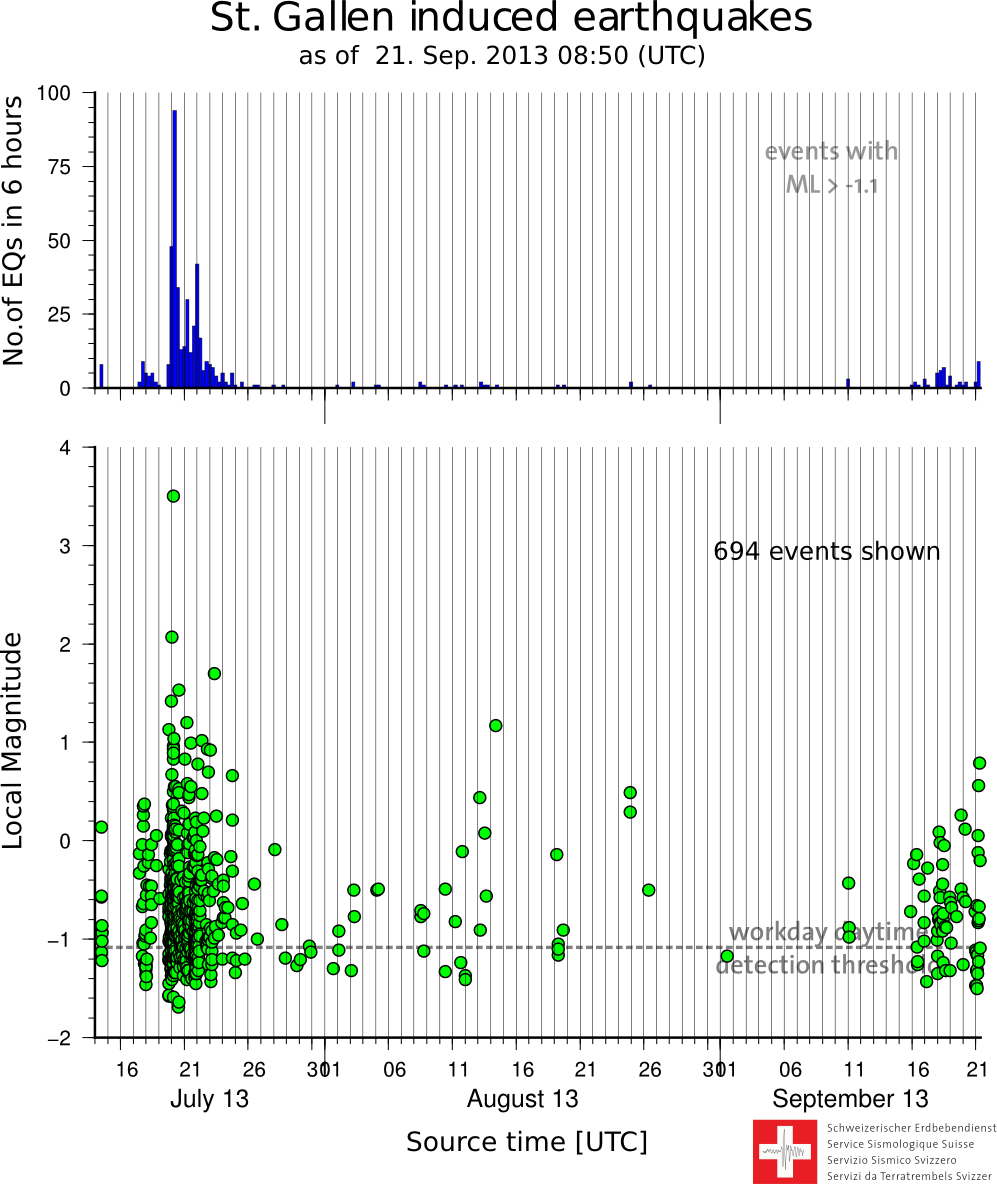
2013-08-28
Geothermal Energy Project in St. Gallen – the Next Steps
On August 27, 2013, St. Gallen city council decided to continue with the geothermal energy project. In its role as an independent observer, the Swiss Seismological Service (SED) is monitoring seismic activity around the drilling rig and carried out a detailed analysis following the strongest earthquake so far, with its magnitude of 3.5. Over the past weeks and months, the SED has provided the St. Gallen public utilities company (Sankt Galler Stadtwerke) and the canton of St. Gallen with a series of updated findings as a basis for decision-making.
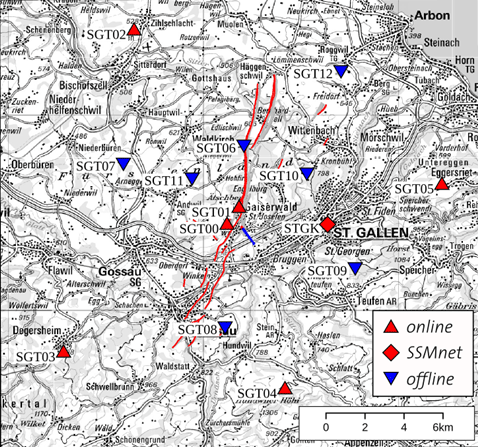
2013-08-28
Initial Investigation Results from the SED in Connection with the Geothermal Energy Project in St. Gallen
In the area surrounding the drilling rig, the SED’s seismic network registered 622 earthquakes with magnitudes ranging from –1.7 to 3.5 up to August 27, 2013. Seismic activity has declined continuously as anticipated since July 14, whereby the number of events registered varies slightly from day to day. The probability of another noticeable earthquake is estimated at between 10 and 20 percent over the next 12 months without further interference with the subsoil. The likelihood of the occurrence of an earthquake with a magnitude of 3.5 or above is between 1 and 3 percent.
The initial investigation results based on collated data material indicate that the subsoil in St. Gallen reacted intensely to the volumes of water injected and the overall pressure conditions. At the present time, we assume that this can be explained by the critical tectonic tension in the fault zone involved in the drilling. Based on the observed induced seismic activity, the fault zone is considered to be an active fracture zone that is also suspected to be responsible for previous natural earthquakes in the St. Gallen region.
Read more...Contrary to an error made commonly even in specialist circles, small earthquakes do not reduce the risk of larger earthquakes occurring within a fault zone. The earthquake that took place on July 20 with a magnitude of 3.5 thus had only a small, inconsequential effect on the overall tectonic tension on the fault plane. In addition, according to our findings it cannot be ruled out that future earthquakes may activate larger subsections of a fault and thereby cause stronger tremors. It is possible that the earthquake that took place in Abtwil in 1835 with a magnitude of 4.7 activated several segments of the St. Gallen fracture zone. Based on today’s circumstances, a comparable earthquake would potentially cause damage costing between CHF 50 million and CHF 200 million.
In terms of the next steps, the SED considers a production test to be less risky than another high-pressure injection. However, an extraction (e.g. in the event of a production test), particularly from a fault zone that has shown itself to be easy to activate, is also not without its seismic risks. It is currently not possible to provide a reliable assessment of the probability of a further noticeable earthquake capable of causing damage and caused by a production test. This probability can, however, be reduced significantly by taking a cautious approach and by terminating the production test prematurely following an unexpected occurrence of microearthquakes. The test should therefore be carried out when the detection capacity of the seismic network is at its best (at night or weekends). Any renewed injection of water or drilling fluid into the fault zone must be avoided.
In order to counter the possible increase in pressure due to the penetration of gas, the use of the otherwise common counterpressure procedure should be avoided if possible. Before larger quantities of water are injected into or extracted from a zone such as this (again), we believe that a broadly based, independent and unbiased risk assessment must have concluded that the associated earthquake risk is acceptable.
The SED is continuing to perform seismic monitoring of the geothermal energy project in collaboration with the St. Gallen public utilities company and the Swiss Federal Office of Energy, and is analyzing the data it receives on an ongoing basis. Details of current seismic activity in the St. Gallen region, as well as further information, can be found on our website at all times.
Presentation by the SED at the media conference in St. Gallen on August 27, 2013
2013-08-14
Earthquakes: Geothermal Energy Project in St. Gallen
Calibration of the Magnitude Determination Reveals the Smallest Earthquakes Localized in Switzerland
For the earthquakes encountered in the scope of the geothermal energy project in St. Gallen, it has only been possible up to now to determine the earthquake magnitudes for a small number of slightly stronger events. The majority of the events were so small that they were recorded only at a few nearby stations. Thus, the signals are strongly influenced by local conditions and do not allow a reliable calculation of the magnitude.
For the earthquakes near St. Gallen, the SED previously used the logarithm of the signal strength (log10(amplitude)) at the borehole station SGT00 as a measure of the size of the events (see left panel of the figure). The values were then normalized to the magnitude of the strongest earthquake (ML = 3.5) that was reliably determined at the stations of the national monitoring network.
Read more...Using the data acquired in the context of the geothermal energy project in St. Gallen, it was possible to calibrate the magnitude calculation specifically for the stations of the St. Gallen network, thereby allowing the local magnitudes to now be reliably determined for small quakes at the geothermal borehole (see right panel of the figure). In the future, these magnitude values will be used for the figures.
Thanks to the new calibration of the magnitudes, it is clear that the SED not only recorded the largest induced quake in Switzerland during the geothermal energy project in St. Gallen, but also localized the smallest earthquakes ever recorded in Switzerland. These quakes have magnitudes down to ML = –1 and occurred on rupture surfaces with diameters of just a few decimeters. (Events with magnitudes less than –1 are, in fact, measured, but cannot be localized with any degree of accuracy.)
Earthquakes of this magnitude close the gap between laboratory experiments and natural seismicity and may provide a better understanding of the physics of earthquakes and help improve earthquake models.
The calibrated local magnitudes are somewhat smaller than the magnitude values for the larger St. Gallen events calculated in the standard way. Thus, there are small differences at present between the values in the earthquake lists and those in the figures.
2013-08-09
Earthquakes: Geothermal Energy Project in St. Gallen: Entry of August 9, 2013
The test and stimulation activities carried out as part of the planned geothermal energy project in Sittertobel near St. Gallen began on July 14, 2013. The number and intensity of the microearthquakes induced were as expected and not noticeable to local residents. On the evening of July 19, seismic activity began to increase; the earthquakes became stronger and more frequent. The sequence achieved the highest peak so far on the morning of July 20, with a perceptible quake with a magnitude of 3.5. According to the latest findings, these earthquakes are directly linked to the steps taken to tackle the gas-water leak observed at midday on July 19.
Read more...Since then, seismic activity has fallen steadily. However, stronger quakes can still not be ruled out. The Swiss Seismological Service (SED) continues to monitor seismic activity in St. Gallen around the clock with the help of a dense, local network. The graph on the left shows the most recent record of seismic activity. Quakes with a magnitude of less than 0.5 are generally too weak to be accurately localized in the course of routine evaluation. They are not, therefore, registered in the regular earthquake lists. However, they can be recorded and clearly attributed to the seismic activity at the borehole.
The SED is currently analyzing the data collected in order to gain a better understanding of the processes responsible for the observed earthquakes, and to then possibly derive forecasts for the further course of these and other quake sequences
2013-07-26
Earthquake in St. Gallen: current situation on July 26, 2013
Seismic activity has declined further in recent days. Up to and including today the Swiss Seismological Service (SED) has recorded more than 550 earthquakes, whereby, apart from the main earthquake with a magnitude of 3.6 (adjusted to magnitude 3.5 on 20.07.2013), only two were strong enough to be noticed by the population. In the coming days we expect a further reduction in seismic activity, although other, stronger earthquakes remain a possibility.
Following initial analysis of the aftershock sequence, it is clear that the seismic activity is declining in a manner similar to that associated with tectonic (natural) earthquakes. About two-thirds of the anticipated aftershocks have already occurred. According to our estimates the probability of a further, noticeable earthquake is in the 10 to 30 percent range. The probability that another earthquake occurs with a magnitude similar to or greater than the main tremor on July 20, 2013, is two to five percent.
Read more...The SED presented these observations together with further provisional results from initial investigations to the authorities in St. Gallen on Friday, July 26, 2013. The SED’s analysis concentrates on understanding in detail the processes underlying the observed seismic activity with the intention of being able to forecast the further course of this and other earthquake sequences. Besides this, comparisons were made with seismic data recorded in the course of other geothermal energy projects.
From the Earthquake Catalog of Switzerland (ECOS-09) it is known that several tectonic earthquakes have occurred in the St. Gallen region in the past. Most earthquakes in the St. Gallen area were relatively weak, with only three known to have caused damage. There was one near Niedersommeri on August 11, 1771, with a magnitude of 5.1, and two with a magnitude of 4.7, one near Arbon on December 20, 1720, and the other near Abtwil on October 29, 1835. Because the data for these earthquakes stems from historical documents, the information about locations and earthquake parameters may not be entirely reliable.
2013-07-23
Earthquake in St. Gallen: current situation on July 23, 2013
As on the previous two days, seismic activity was slightly down by the evening of July 23, 2013, with the strongest quake having a magnitude of 1.7. More than 550 microearthquakes have been recorded in total.
In parallel to the recording of the current seismic activity, the Swiss Seismological Service (SED) is analyzing the data recorded thus far by the six stations built to monitor the geothermal energy project. Yesterday, our technicians also collected the data from four other stations. This data will also be incorporated into the investigations. The four temporary seismometers were installed on June 4, 2013, in order to observe the test and stimulation phase even more closely. While the six permanent stations send their recordings to Zurich in real time, the temporary seismometers record them locally.
There are currently over 400 reports from people who felt the earthquake last Saturday (Report an earthquake). Most of those affected felt a bang and a bump, with many mentioning two bumps in quick succession (approximately 1 second). Only a minority reported moving objects, flapping doors, or swinging lampshades. Compared with the quake triggered by the Deep Heat Mining Project in Basel (magnitude of 3.4) on December 8, 2006, the one in St. Gallen was felt by significantly fewer people, despite its slightly greater magnitude.
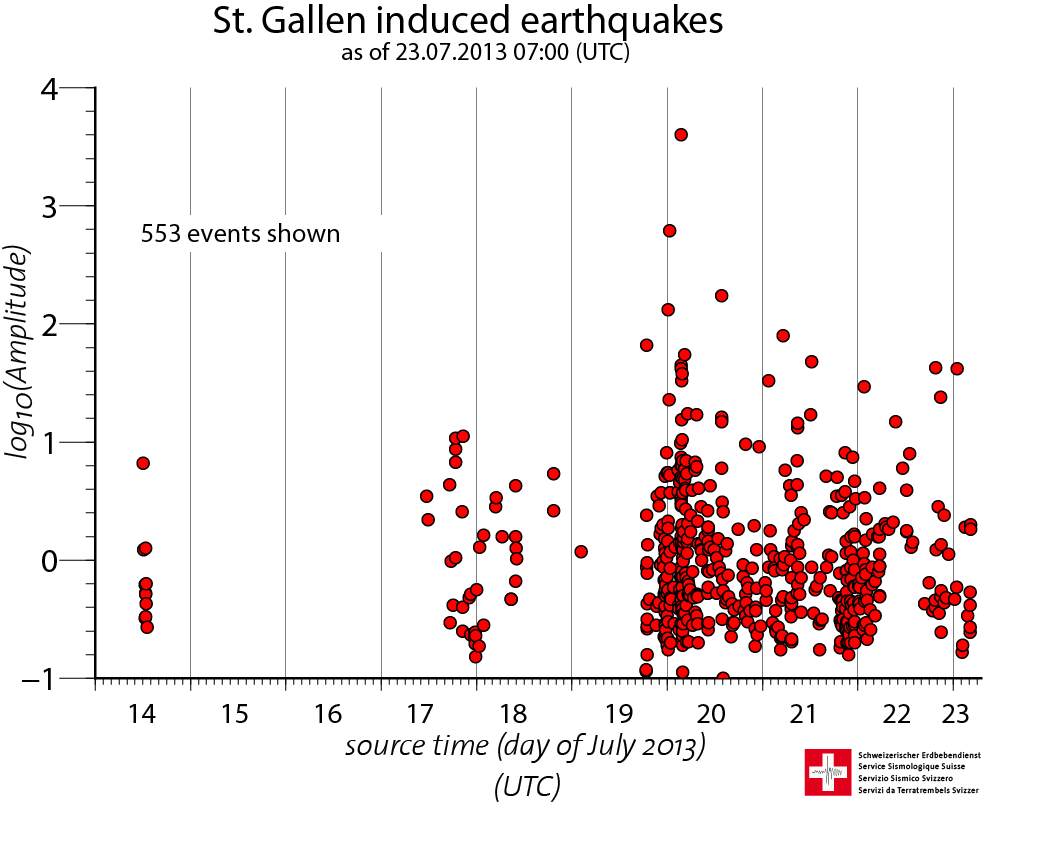
2013-07-22
Earthquake in St. Gallen: current situation on July 22, 2013
Since the St. Gallen public utilities company (Sankt Galler Stadtwerke) ended the testing and stimulation measures last Friday and the situation in the borehole stabilized, seismic activity around the borehole has remained stable at a low level (see diagram to left). Although the situation has now calmed down, further microearthquakes are expected and larger quakes cannot be ruled out. Initial estimates suggest it could be more than a year before seismic activity returns to the natural level previously observed. The strength and frequency of the quakes is set to diminish over time. The Swiss Seismological Service (SED) is currently analyzing seismic data from the last few days and will publish its latest findings here as they become available.
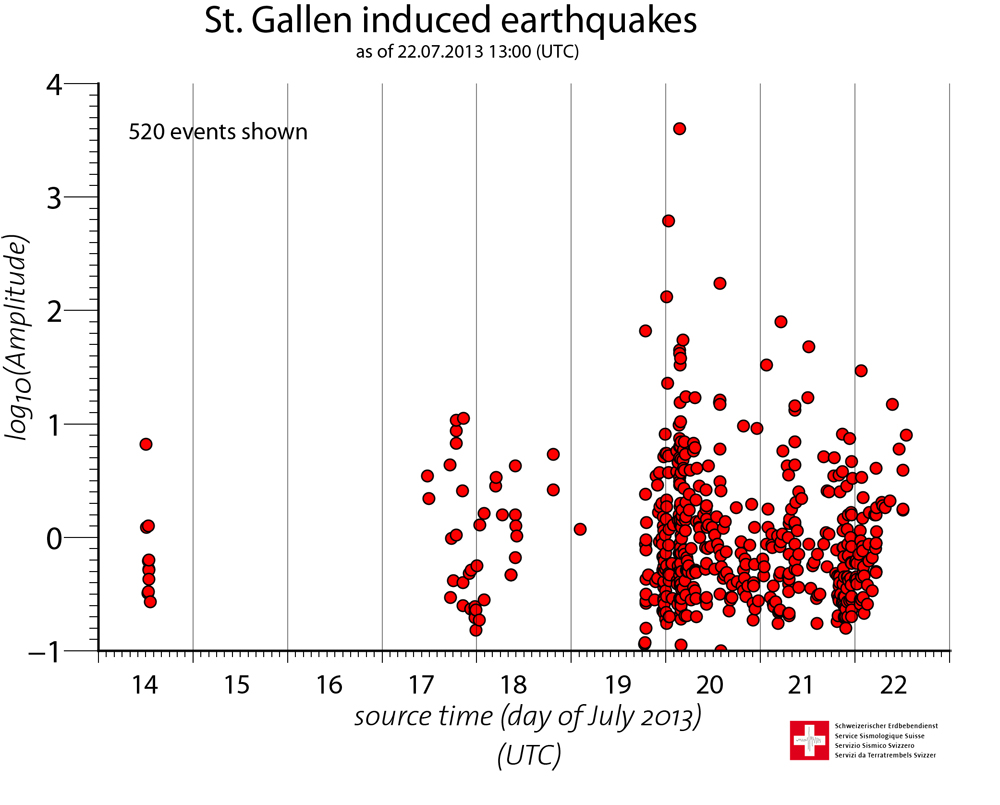
2013-07-20
Earthquake near St. Gallen clearly felt
The Swiss Seismological Service (SED) at the ETH Zurich has registered an earthquake with a magnitude of 3.6 at a depth of 4 kilometers in the morning of July 20, 2013, at 5:30 local time near St. Gallen. The earthquake was felt widely in the region. With an earthquake of that magnitude and depth, slight damage to buildings cannot be ruled out.
The quake is likely directly related to the tests and stimulation activities in the borehole of the planned St. Gallen geothermal project, where numerous micro-earthquakes have already occurred at the base of the borehole in recent days. In the night of July 19 to July 20, 2013, the number and magnitude of earthquakes increased significantly. An initial, slightly more powerful earthquake with a magnitude of 2.1 occurred at 2:40 local time on the morning of July 20. This earthquake was possibly felt in the immediate area in individual instances.
Read more...The seismic activity seems to be decreasing in the course of the morning of July 20; a few small additional earthquakes have been recorded since the early hours, though these have not exceeded 1.4 in magnitude. However, further quakes cannot be ruled out within the next days, according to our assessment.
The SED continues to monitor seismic activity around the clock, and will investigate the earthquakes in greater detail.
Further information regarding the seismic monitoring of the geothermal project
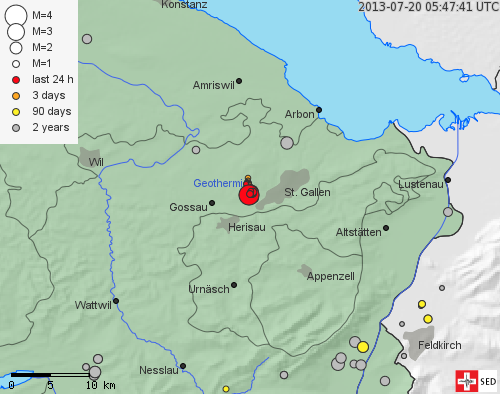
2013-07-20
Earthquake at geothermal drilling site in St. Gallen
Test and simulation activities carried out as part of the planned geothermal energy project in Sittertobel near St. Gallen began on July 14, 2013. A series of related microearthquakes was registered between July 14 and 19, with the strongest reaching a local magnitude of 0.9 on the Richter magnitude scale. These small quakes occurred near to the base of the borehole, at a depth of approximately four kilometers, and were too weak to be felt by local residents. The scope of the earthquakes was as had been anticipated.
Seismic activity started to increase on the evening of July 19, 2013, with the earthquakes becoming stronger and more frequent. At the same time, the pressure in the borehole mounted, most likely due to the gas that had penetrated into it. The strongest earthquake by far, with a magnitude of 3.6, occurred at 5.30 a.m. local time on the morning of July 20, 2013, and was also registered at a depth of four kilometers. The quakes continued until around 11 a.m., but were subsequently significantly weaker (magnitudes of below 1.5).
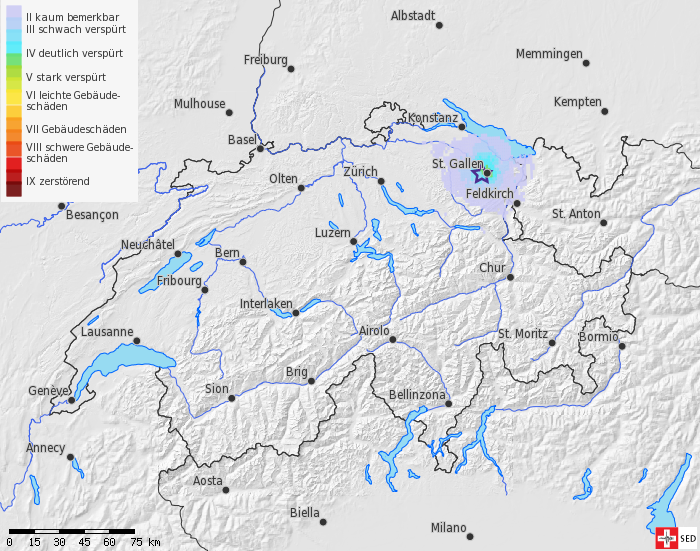
The earthquake with a magnitude of 3.6 was felt within a radius of approximately 15 kilometers. By Saturday morning, the Swiss Seismological Service had received notifications from some 400 residents.
No damage is generally anticipated following an earthquake of this magnitude, which would broadly appear to be the case for the earthquake on Saturday morning, with only a few reports of cracks in plaster having been received.
Further microearthquakes are likely to occur during the coming days. It cannot be ruled out, however, that stronger quakes will be felt and damage will occur. Currently (as of the afternoon of July 20, 2013), seismic activity has declined significantly, due to the normalization of pressure in the borehole.
The on-call service from the Swiss Seismological Service (SED) is monitoring seismic activity around the clock, and spent the night of July 19 to 20, 2013, in close contact with the individuals responsible in St. Gallen. The SED will provide up-to-date information on a regular basis and investigate the earthquakes in greater detail.
Further information about the seismic monitoring of the geothermal energy project can be found here
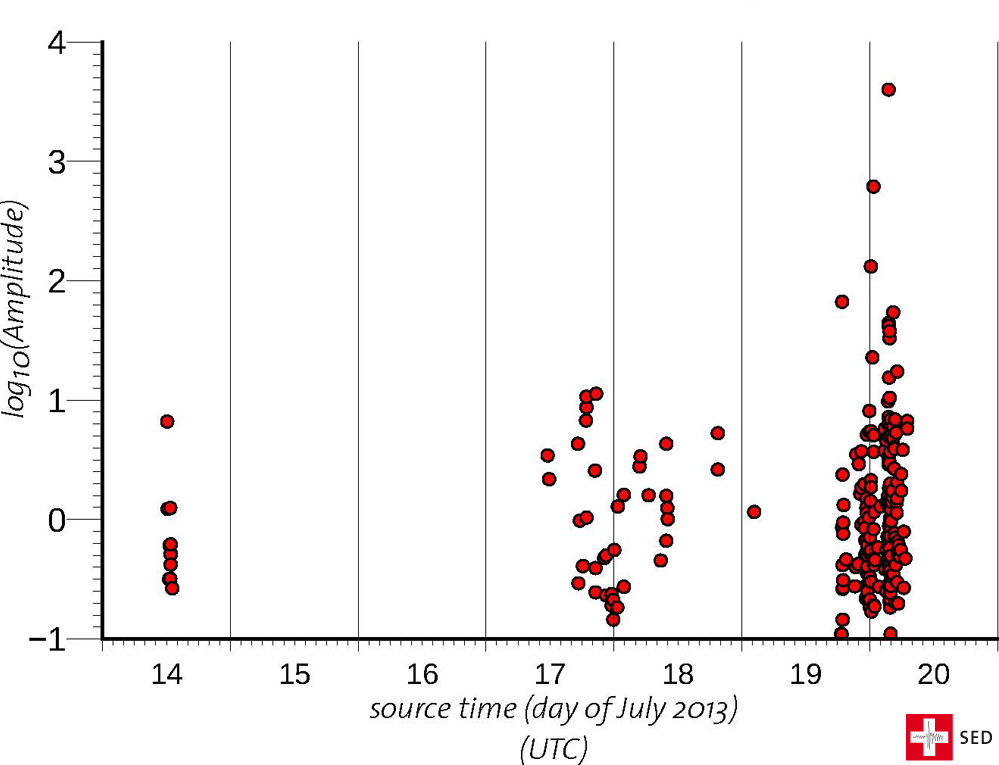
2013-07-19
Microearthquakes recorded near deep borehole in St. Gallen
As part of the planned St. Gallen geothermal energy project, test and simulation measures are currently being performed in geothermal reservoir rocks at a depth of 4,000 to 4,500 meters. The Swiss Seismological Service (SED) is monitoring this work with a dense network of six seismological stations, within the scope of the GeoBest project and in collaboration with the St. Gallen public utilities company (Sankt Galler Stadtwerke) and the Swiss Federal Office of Energy.
Since the start of the test program on July 14, 2013, the SED has, as was expected, registered several microearthquakes that could be localized near the bottom of the GT-1 deep borehole in St. Gallen. The microearthquakes are so small that they can only be recorded at the stations of the network, which was set up specifically for monitoring. A local earthquake magnitude of ML = 0.9 on the Richter magnitude scale was determined for the strongest quake, which occurred on July 14, 2013, at 12.06.35 p.m. (UTC). Earthquakes of this size cannot be felt by people.
The currently observed seismicity near the geothermal borehole GT-1 has so far been in line with expectations and, based on our assessment, poses no cause for concern. The greater St. Gallen area will continue to be monitored around the clock for seismic activity and the results provided in real time to the St. Gallen public utilities company. It is thereby ensured that the test and simulation program can be modified or discontinued if necessary in accordance with the response plan developed in advance by the St. Gallen public utilities company. The SED will continue to perform detailed seismic monitoring in the coming months.
2013-07-19
Mikrobeben nahe der Tiefbohrung St. Gallen aufgezeichnet
St Gallen Mikrobeben 14. bis 18. Juli 2013
Beim geplanten Geothermieprojekt St. Gallen werden derzeit Test- und Stimulationsmassnahmen im geothermischen Reservoirgesteine in einer Tiefe von 4000 bis 4500 Metern durchgeführt. Unter Druck wird dabei für einige Stunden verdünnte Salzsäure in das Gestein in der Nähe des Fusspunkts der Tiefbohrung Sankt Gallen GT-1 eingebracht, um das Bohrloch von Bohr- und Gesteinsresten zu reinigen und dieses hydraulisch besser an das umgebende Gestein anzukoppeln. Der Schweizerische Erdbebendienst (SED) überwacht diese Arbeiten mit einem dichten Netz von sechs Erdbebenstationen, im Rahmen des Projektes GeoBest und in Zusammenarbeit mit den Sankt Galler Stadtwerken (sgsw) und dem Bundesamt für Energie.
Read more...Ziel der Überwachung ist es einerseits, die mechanischen und chemischen Prozesse bei Tiefbohrungen besser zu verstehen. Andererseits kann der SED die sgsw so frühzeitig auf ungewöhnliche seismische Aktivität hinweisen.
Seit dem Beginn des Testprogramms am 14. Juli 2013 hat der SED wie erwartet einige Mikrobeben registriert, die im Bereich des Fusspunktes der Tiefbohrung lokalisiert werden konnten. Die Mikrobeben sind so klein, dass sie nur an den Stationen des speziell für die Überwachung errichteten Netzwerkes aufgezeichnet werden konnten. Für das stärkste Beben, am 14. Juli 2013 um 12:06:35 (UTC), wurde eine von Lokalbebenmagnitude (Richterskala) von ML=0.9 bestimmt. Beben dieser Grösse können von Menschen nicht verspürt werden.
Aufgrund der geringen Stärke und der daher recht schwachen Signale ergeben sich Unsicherheiten in der Lokalisierung von ungefähr einem Kilometer. Die sehr grosse Ähnlichkeit der Seismogramme, wie sie z.B. an der Bohrlochstation SGT00 beobachtet werden (siehe Abbildung), deutet darauf hin, dass die Erdbeben in einem Abstand von wenigen 100 Metern voneinander aufgetreten sind.
Neben den lokalisierbaren Mikrobeben, die auf den Erdbebenlisten des SED aufgeführt sind, wurden über 40 weitere Kleinsterdbeben an der Bohrlochstation SGT00 aufgezeichnet, die in 205m Tiefe direkt über dem Fusspunkt der Tiefbohrung GT-1 eingerichtet wurde. Diese Erdbeben gehören zu den kleinsten jemals in der Schweiz registrierten Erdbeben. Die von ihnen ausgesandten Erdbebenwellen sind ca. 500 mal kleiner als jene des bisher stärksten Bebens der Sequenz (siehe oben) und haben Lokalmagnituden im negativen Bereich (bis ML ~ -1.0).
Die derzeit beobachtete Seismizität im Bereich der Geothermiebohrung GT-1 entspricht bisher den Erwartungen und stellt somit unserer Einschätzung nach keinen Grund zur Beunruhigung dar. Der SED wird die detailliert seismische Überwachung auch in den nächsten Monaten weiter führen.
